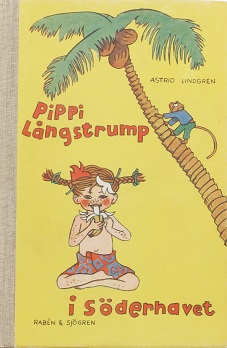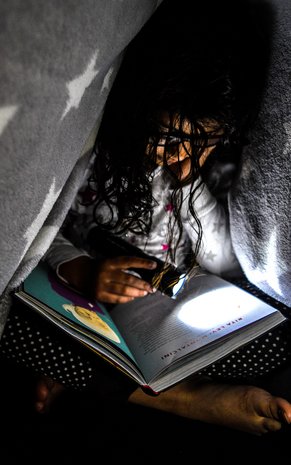Racism in classic pieces of Nordic children's literature
Racial prejudice in many Nordic children’s classics can be overt or more subtly embedded. The republishing of some of these controversial books in e.g. Sweden and Iceland discloses contemporary views of race and reveals how the past is positioned in contemporary Nordic society.

Some of the most beloved figures in Nordic children’s literary classics from the 20th century are rooted in narrow-minded caricatures, and racial prejudice can be so subtly embedded in many older pieces of literature that even contemporary readers are blinded to it. The discussion surrounding the republishing of some of these controversial books provides interesting perspectives on contemporary views of race and racism, but it also reveals the importance of contextualising these perceptions within a national, historical context. It is important to consider how the past is used in the present and how it is made meaningful in the Nordic societies.
Racist elements edited from Nordic children's books
Up until at least 1950, the Nordic countries as well as the rest of Western Europe were dominated by a racial understanding which was significantly influenced by a colonial mindset. However, as a consequence of the atrocities of Nazism, the emancipation movement in the USA and elsewhere and so on, there has since then been an extensive revision in understandings of race. ‘Racism’ is now too easily looked upon as something that is past, something that should be associated with the historical era of colonialism, race biology and Nazism. This modernist attitude, combined with a general lack of knowledge of the Nordic countries’ history as former colonisers, can produce an image of the Nordic countries as mono-cultural and racially homogenous states.
During the time of high imperialism, a range of words, names and expressions were used by Europeans to describe minorities both in the colonies and within Europe itself. These terms were used within scientific contexts, as well as in the cultural sphere and in daily life. However, since the formal decolonisation of the post-WWII period, the overt use of racially detonated words such as these has been contested by minorities and antiracists all over the world.
Language is often loaded with power-relations, and racially-detonated words are no different. Discussion over the language of racial discourse has manifested itself in a variety of ways, not least in public pressure to change aspects of cultural heritage, including classic works of children’s literature. Over the years, many beloved children’s books have been put under the microscope for depicting increasingly problematic stereotypes. At the same time, however, this shift in public opinion about the acceptability of overtly racist language has played out against a conservative backlash against so-called ‘reverse racism’ and ‘political correctness.’ This comes in part from white majority populations who often derive a sentimental nostalgia from certain works of literature – particularly those from their childhood.
In recent years, there have been a number of heated debates throughout the Nordic region about the ongoing use of words and illustrations in children’s literature with a racial undertone that reflect colonial power relations. They revolve around the presence and the replication of stereotypical racial depictions in certain pieces of literature. As the Nordic countries generally view themselves as antiracist and post-racial societies, these debates have often raised uncomfortable questions about what is right and wrong, as well as in regard to the Nordic countries’ involvement in a colonial past. Beloved books written in a different age often have attitudes that are no longer viewed as acceptable by wider society. Some – but not all – of these children’s stories are therefore now being edited to remove racist references. However, there is a fine balance in finding a way to deal with these issues while preserving an important recognition of how things were in the past - for better or for worse. The books did not change - the world did.

Picture: 1st edition of Pippi Longstocking in the South Seas, published in 1948. Pippi goes on an adventure to find her father who mysteriously disappeared, and discovers that he has been named "King of the Negroes" on a remote island. In the republication of 2015, his title was changed to "King of the South Seas". Wikimedia, Fair use.
Pippi Longstocking’s colonialist parent
In 2015, in connection with the 70th anniversary of its first publication, the collected stories of Pippi Longstocking were republished in Sweden in a revised version. Several scholars have pointed to the fact that the stories about Pippi, written in the 1940s by beloved Swedish writer Astrid Lindgren (1907-2002), have strong colonial racist stereotypes. Because of this, in the amended version, Pippi’s father who had previously been referred to as ‘King of the Negroes’ was given the new title ‘King of the South Seas’. Pippi Longstocking, a high-spirited girl strong enough to lift a horse, has functioned as a trademark for generations of children who have read her stories in 65 languages worldwide.
In her home country, Sweden, Pippi is something more, though; she is a national treasure and an embodiment of the country’s spirit. Because of the story’s important status as a classic piece of Swedish literature, the revision hit a nerve in Swedish society. It is not hard to see why the book is so popular; apart from contested colonial racism, it includes many very positive aspects, not least the strong female main character and a sharp critique of authority. According to the author’s daughter who now holds the rights to the books and had the final say on the issue of rewriting, Lindgren herself distanced herself from the original text as early as the 1970s. She is therefore certain that the original author would have had nothing against the rewriting, as “[Lindgren] was a pragmatic children’s book author who adjusted her texts when needed. The child's perspective was always the most important to her”.
While Sweden has a reputation for being politically correct (even to the extreme), they also have the most diverse population of the Nordic countries. Recent decades have particularly seen a rise in non-white immigration and interracial marriages, leading to a more multicultured society. This development in the demography has created a paradoxical self-image in which ethnicity is considered as no longer an issue in some spheres of society, such as the progressive, tolerant, antiracist Sweden. On the other hand, controversial issues such as racist children’s literature are deeply relevant to other groups. For many white-majority Swedes, the Swedish word ‘neger’ (‘Negro’) is not considered a racist, demeaning word in the same way as its English counterpart. This complex debate continues, but it is interesting to note that the use of the word persists despite protests and strong disagreements (see Hübinette, 2013, for more details).
Negrastrákarnir ('The Ten Little Negros’)
The Icelandic version of the nursery rhyme ‘The Ten Little Negros’ was first published in book format in Iceland in 1922 and has been a classic ever since, not least because it was illustrated by the popular Icelandic artist Guðmundur Thorsteinsson (1891-1924), better known under his pseudonym ‘Muggur’. It was republished in its original form in 2007, as it had been several times before. But, as opposed to the previous republications, the 2007 edition sparked a public debate about whether the book still belonged in modern Icelandic society, as explored by anthropologist Kristín Loftsdóttir. The illustrations for ‘The Ten Little Negros’ depicted the boys of the story with “monkey-like bodies, complete with thick red lips and big eyes".
When it was originally published, this type of racist imagery was quite common not only in Iceland, but also in Europe as well as the US, so the book was by no means unique for its time. It is interesting, though, that most of the people who defended the republication of the book in its original form strongly perceived it to be an important part of Icelandic cultural heritage that should not be tampered with because the book was in fact a translation and the images replicate racist imagery from 19th century USA. In this regard, it is especially Muggur’s importance as a symbol of the Icelandic past that makes the book meaningful for those who defended it. But, while the republishing in its original form was defended by many, it was equally contested. Public opinion and debates on the matter were divided into two camps, just as they were in the case of ‘Pippi Longstocking’ – while some thought it would be a shame to make changes to the book, others thought it would be the only right thing to do. The same two viewpoints can be seen in a larger discussion about national identity and multiculturalism in Iceland. The contemporary population of Iceland is far from as monocultural as it once was, which has a knock-on effect on these discussions.

Picture: How do children deal with racist imagery presented to them in classic children's stories? It is only comparatively recently in the Nordic countries that there have been discussions about whether or not these stories should be changed. Photo by Anuja Mary Tilj on Unsplash.
Should Nordic racist children’s books be left in their original form?
The rewriting of problematic children’s literature has been referred to as ‘censorship’ and seen by some as significant interference with a key cornerstone of the Nordic societies, namely, freedom of speech. In less extreme terms, it has raised a concern that the past is in danger of being ‘erased’ in order to cultivate a narrative for the future which is easier to accept than the deplorable colonial history to which these issues often refer. Philip Nel, professor of children’s literature, argues that this form of censorship does not solve the problem; that “ignoring the symptoms does not cure the disease". He argues that removing all racist content, be it words or illustrations, is hard if not downright impossible as the colonial ideology is imbued in more subtle ways, such as in aspects of the characters’ motivations and stories, for example. The advantage of a caricature, he says, is that it is so obvious. And of course, the past must not be forgotten or washed away simply because it is unpalatable. In this way, problematic pieces of children’s literature can be seen as having an educational value in terms of teaching children about race and the history connected to it. By excluding troubling literature from the discussion, children are of course not shielded from pain, bigotry and prejudice – but they may be forced to deal with these things from their own experiences instead of learning about them in a safe environment. In a world which is – still – neither just nor fair, perhaps children will be better equipped to deal with such issues through prejudiced literature.
However, not everyone in the debate is concerned with the historical meaning of the books and their content. In both Pippi Longstocking and Negrastrákarnir, the importance of the books in relation to their native country’s cultural heritage has been highlighted, mainly by people who remember the books from their own childhood. In this way, many people are fond of the books and find them not only beautiful, but also impossible to connect with racism. Rather, they are filled with happy childhood memories and see them as cultural treasures. This nostalgia almost seems to work as an excuse to ignore the problematic aspects of the debate; history is used to justify the outdated racial depictions as people ‘did not know any better back then’ and now it is too deeply rooted in cultural heritage to change.

Picture: It is up to a child's parents to decide what books are suitable for their children. But is nostalgia a good enough reason to hold on to racist imagery from a different time? Photo: Colourbox.
…or should they be edited?
On the other side of the discussion, those arguing for the editing of classic children’s books generally stress that it is difficult not to see the books in question as ‘outdated’ in the context of the contemporary Nordic societies. The argument here is that while the books may be products of their time, both the texts and illustrations reveal a massive amount of prejudice and a horribly outdated, colonial view of non-white ethinicities being seen as worth less than the majority race of the societies they were created in. According to Nel, this is just as damaging for white children as it is for black children: “The white child who encounters the n-word […] has the unearned privilege of not seeing people of her or his race being stereotyped" – prejudice harms different groups differently. Those speaking from the comfortable position of the white majority can either dismiss racism as a thing of the colonial past, thus having no connection to the present, or maintain that racism in classic literature is irrelevant because it was not perceived as such when it was created.
Inevitably, the books in question increasingly appear outdated and out of touch with the values of the modern Nordic countries. Both of the countries in question, as is the case with the whole of the Nordic region, pride themselves on their egalitarianism, but the debate on racist children’s classics show that ethnic minorities, who make up an increasing percentage of all the Nordic populations, have only recently begun to be heard. The Nordic societies are often seen as mono-cultural and racially homogenous states, even though they are quite diverse both culturally and ethnically. These images, combined with a general lack of knowledge of the Nordic countries’ history as former colonisers (see this film on Nordic postcolonialism for more information), affect the countries’ self-perception of perfect egalitarianism.
There is a fine line between ‘fixing’ and ‘erasing’ history. In the light of history, some racial stereotypes are seen as outdated and demeaning. As the Nordic countries have a history of being ‘white colonisers’, it is important to acknowledge the fact that while some terms and images may have been a natural and culturally accepted part of our languages in particular social spheres at one point in time, the negative associations connected to them have gradually become stronger. In this way, history – and the use of history – must be considered carefully and critically. We cannot change history, but there is an important debate to be had in how the youngest generations learn about it.
Further reading
- Kristín Loftsdóttir: “Republishing ‘The Ten Little Negros’: Exploring nationalism and ‘whiteness’ in Iceland”, Ethnicities 13, 3, 2013, pp. 295-315.
- Tobias Hübinette: “Swedish Antiracism and White Melancholia: Racial Words in a Post-racial Society”, Ethnicity and Race in a Changing World: A Review Journal 4, 1, 2013, pp. 24-33.
- Philip Nel: “Was the Cat in the Hat Black?” (Oxford University Press, 2017).
Links
- Washinton Post article, 3 December 2014, 'Sanitized ‘Pippi Longstocking’ raises questions about erasing old racial references'